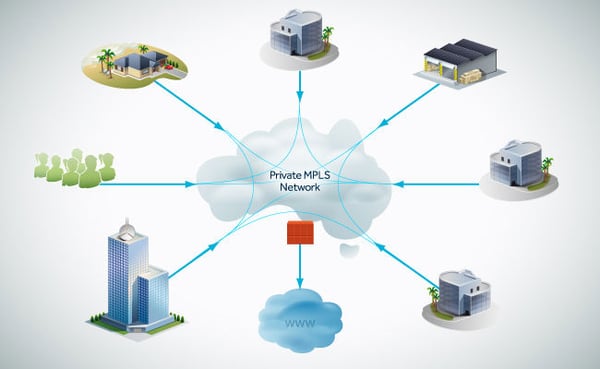The traditional WAN
The traditional WAN function is connecting users at the branch or campus to applications hosted on servers in the data center. Typically, dedicated MPLS circuits are used to help ensure security and reliable connectivity.

Today's Challenges
Times have changed. As businesses race to adopt the use of SaaS/IaaS applications in multiple clouds, IT is realizing that the user application experience is poor. That is because they have not upgraded the WAN network to for the unprecedented explosion of WAN traffic that cloud adoption brings. That traffic causes management complexity, application performance unpredictability, and data vulnerability.
Further opening the enterprise to the Internet and the cloud exposes major threat and compliance issues. It is extremely challenging to protect the critical assets of an enterprise when applications are accessed by a diverse workforce, whose role access ranges from employee to partner, contractor, vendor, and guest. Enabling broadband in the WAN makes the security requirements more acute, creating challenges for IT in balancing the user experience, security, and complexity.
SD WAN (the new WAN option)
SD-WAN, Software-defined WAN is a new approach to network connectivity that lowers operational costs and improves resource usage for multi-site deployments. Network administrators can use bandwidth more efficiently and can help ensure the highest level of performance for critical applications without sacrificing security or data privacy.
As businesses adopt cloud-based application services in the form of SaaS/IaaS, their WAN architecture experiences an explosion of traffic accessing these globally diverse applications. IT is fighting daily to keep up with the complex battle of connecting multiple types of users, over multiple types of devices, to multiple cloud environments.
With SD-WAN, you can deliver routing, threat protection, efficient offloading of expensive circuits, and simplification of WAN network management.
A few benefits include:
Application experience
- High availability on all critical enterprise applications
- Multiple hybrid active-active links for all network scenarios
- Dynamically route application traffic to drive efficient delivery
Integrated security
- Application-aware policies with real-time enforcement around network problems
- Integrated threat protection
- Secure traffic flow across broadband Internet
Cloud optimized
- Seamlessly extend the WAN to multiple public clouds
- Real-time optimized performance for Office 365, Salesforce, and other major SaaS applications
- Optimized workflows for cloud platforms like AWS and Azure
Operational simplification and security
- Single, centralized management dashboard for configuration and management of WAN, cloud, and security
- Template-based, zero-touch provisioning for all locations
- Detailed applications and WAN performance reporting for business analytics
Primary value proposition for SD WAN
The primary value proposition for SD-WAN centers on the high cost of traditional WAN. As the internet has grown, it has become easier (and cheaper) to get broadband internet circuits just about anywhere. For many users, high speed bandwidth was no longer a benefit of driving to the office. In situations where upgrading the bandwidth of your MPLS is not cost effective or to ad redundancy SD WAN is a great option.

More Options with Less Complexity
MPLS has been the dominant form of enterprise WAN over the past few decades but it finally has a very viable competitor in SD-WAN. MPLS circuits provide a dedicated network that is completely distinct from any other network. Every remote connection has a specifically sized circuit delivered to them so you know exactly how much bandwidth you get at each site…it is all very predictable. Which is important. If any location needs to access ‘the internet’ than this is commonly done by routing that connection through a central office which has big pipes to the internet and various security mechanisms for filtering it.
Two issues with traditional MPLS design:
- All internet traffic from branch sites is using those precious/expensive MPLS in two directions. This is secure….but wasteful.
- Internet use is rising fast with multiple Saas or IaaS resources are now used by the entire enterprise.
Enterprise IT has long been able to connect to the Internet directly from any remote office. This is not a new idea. It just came with too much risk.
SD-WAN is now offering a credible option for enabling a secure ‘hybrid’ WAN. The hybrid is a reference for how SD-WAN is here to augment, not necessarily replace those expensive MPLS circuits with a less expensive broadband internet.



